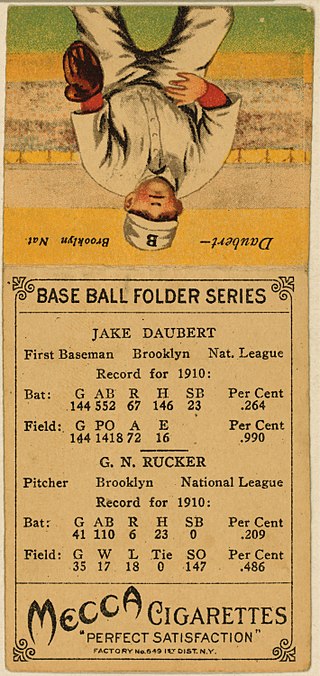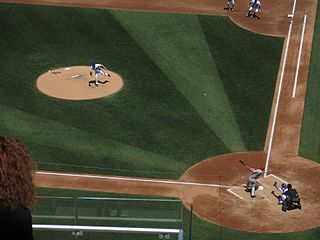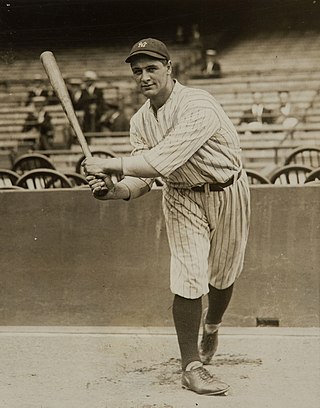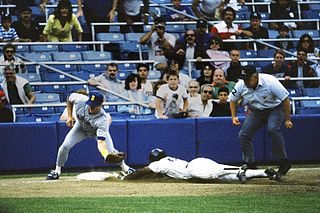
Baseball statistics include a variety of metrics used to evaluate player and team performance in the sport of baseball.

In baseball, an at bat (AB) or time at bat is a batter's turn batting against a pitcher. An at bat is different from a plate appearance. A batter is credited with a plate appearance regardless of what happens during their turn at bat, but a batter is charged with an at bat only if that plate appearance does not have one of the results enumerated below. While at bats are used to calculate certain statistics, including batting average and slugging percentage, a player can qualify for the season-ending rankings in these categories only if they accumulate 502 plate appearances during the season.
In baseball, an earned run is any run that was fully enabled by the offensive team's production in the face of competent play from the defensive team. Conversely, an unearned run is a run that would not have been scored without the aid of an error or a passed ball committed by the defense; it is "unearned" in that it was, in a sense, "given away" by the defensive team.
In baseball, a sacrifice fly is defined by Rule 9.08(d): "Score a sacrifice fly when, before two are out, the batter hits a ball in flight handled by an outfielder or an infielder running in the outfield in fair or foul territory that
- is caught, and a run scores after the catch, or
- is dropped, and a runner scores, if in the scorer's judgment the runner could have scored after the catch had the fly ball been caught."

In baseball, a player is credited with a plate appearance each time he completes a turn batting. Under Rule 5.04(c) of the Official Baseball Rules, a player completes a turn batting when he is put out or becomes a runner. This happens when he strikes out or is declared out before reaching first base; or when he reaches first base safely or is awarded first base ; or when he hits a fair ball which causes a preceding runner to be put out for the third out before he himself is put out or reaches first base safely. A very similar baseball statistic, at bats, counts a subset of plate appearances that end under certain circumstances.

Baseball is a bat-and-ball sport played between two teams of nine players each, taking turns batting and fielding. The game occurs over the course of several plays, with each play generally beginning when a player on the fielding team, called the pitcher, throws a ball that a player on the batting team, called the batter, tries to hit with a bat. The objective of the offensive team is to hit the ball into the field of play, away from the other team's players, allowing its players to run the bases, having them advance counter-clockwise around four bases to score what are called "runs". The objective of the defensive team is to prevent batters from becoming runners, and to prevent runners' advance around the bases. A run is scored when a runner legally advances around the bases in order and touches home plate.

Sabermetrics is the original or blanket term for sports analytics, the empirical analysis of baseball, especially the development of advanced metrics based on baseball statistics that measure in-game activity. The term is derived from the movement's progenitors, members of the Society for American Baseball Research (SABR), founded in 1971, and was coined by Bill James, who is one of its pioneers and considered its most prominent advocate and public face.
In baseball, a sacrifice bunt is a batter's act of deliberately bunting the ball, before there are two outs, in a manner that allows a baserunner to advance to another base. The batter is almost always put out, and hence sacrificed, but sometimes reaches base on an error or fielder's choice. In that situation, if runners still advance bases, it is still scored a sacrifice bunt instead of the error or the fielder's choice. Sometimes the batter may safely reach base by simply outrunning the throw to first; this is not scored as a sacrifice bunt but rather a single.
Runs created (RC) is a baseball statistic invented by Bill James to estimate the number of runs a hitter contributes to their team.

In baseball, the batting order or batting lineup is the sequence in which the members of the offense take their turns in batting against the pitcher. The batting order is the main component of a team's offensive strategy. In Major League Baseball, the batting order is set by the manager, who before the game begins must present the home plate umpire with two copies of his team's lineup card, a card on which a team's starting batting order is recorded. The home plate umpire keeps one copy of the lineup card of each team, and gives the second copy to the opposing manager. Once the home plate umpire gives the lineup cards to the opposing managers, the batting lineup is final and a manager can make changes only under the Official Baseball Rules governing substitutions. If a team bats out of order, it is a violation of baseball's rules and subject to penalty.

Throughout the history of baseball, the rules have frequently changed as the game continues to evolve. A few common rules most professional leagues have in common is that four balls is a base on balls, three strikes is a strikeout, and three outs end a half-inning.

In baseball, a cleanup hitter is the fourth hitter in the batting order. The cleanup hitter is traditionally the team's most powerful hitter. His job is to "clean up the bases", that is, drive in base runners.

In baseball, batting is the act of facing the opposing pitcher and trying to produce offense for one's team. A batter or hitter is a person whose turn it is to face the pitcher. The three main goals of batters are to become a baserunner, to drive runners home or to advance runners along the bases for others to drive home, but the techniques and strategies they use to do so vary. Hitting uses a motion that is virtually unique to baseball and its fellow bat-and-ball sports, one that is rarely used in other sports. Hitting is unique because it involves rotating in the horizontal plane of movement, unlike most sports movements which occur in the vertical plane.

A box score is a chart used in baseball to present data about player achievement in a particular game. An abbreviated version of the box score, duplicated from the field scoreboard, is the line score. The Baseball Hall of Fame credits Henry Chadwick with the invention of the box score in 1858.

Pesäpallo is a fast-moving bat-and-ball sport that is often referred to as the national sport of Finland and has some presence in other places including Germany, Sweden, Switzerland, Australia, and Canada's northern Ontario. It is similar to brännboll, rounders, lapta, and baseball.

Baseball scorekeeping is the practice of recording the details of a baseball game as it unfolds. Professional baseball leagues hire official scorers to keep an official record of each game, but many fans keep score as well for their own enjoyment. Scorekeeping is usually done on a printed scorecard and, while official scorers must adhere precisely to one of the few different scorekeeping notations, most fans exercise some amount of creativity and adopt their own symbols and styles.
A clutch hitter is a baseball player who is seemingly adept at getting a hit in high-pressure situations, i.e. in the clutch. This usually refers to getting a hit when the player's team is trailing late in a game and needs to score to tie or take the lead, especially if there are already two outs in the inning and/or the batter already has two strikes. That said, a clutch hit can occur at any point in the game if the circumstances are similarly high-stakes. Establishing a reputation as a clutch hitter is desirable for a player. Although clutch hits are recorded no differently than any other hit for statistical purposes, the notion that a player is more likely to produce clutch hits compared to other players can be advantageous in contract negotiations.

In the sport of baseball, small ball is an informal term for an offensive strategy in which the batting team emphasizes placing runners on base and then advancing them into scoring position for a run in a deliberate, methodical way. This strategy places a high value on individual runs and attempts to score them without requiring extra base hits, or sometimes without base hits at all, instead using bases on balls, stolen bases, sacrifice bunt or sacrifice fly balls, the hit-and-run play, and aggressive baserunning with such plays as the contact play. A commonly used term for a run produced playing small ball is a "manufactured run". This style of play was more often found in National League game situations than in the American League due in large part to the absence of the designated hitter in the National League until the universal adoption of the Designated Hitter.
This is an alphabetical list of selected unofficial and specialized terms, phrases, and other jargon used in baseball, along with their definitions, including illustrative examples for many entries.
Batting average is a statistic in cricket, baseball, and softball that measures the performance of batters. The development of the baseball statistic was influenced by the cricket statistic.












